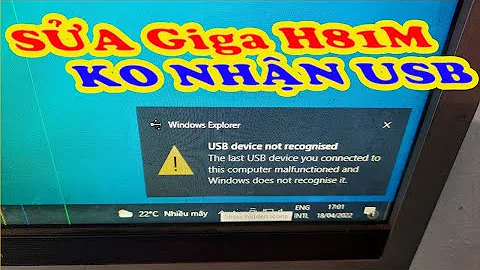Why does lsusb show devices connected to a USB 3 port as connected to USB2 root hub?
Solution 1
Why does lsusb show USB2 devices connected to a USB3 port as being attached to the USB 2 root?
Answer :
In USB 3.0, dual-bus architecture is used to allow both USB 2.0 (Full Speed, Low Speed, or High Speed) and USB 3.0 (SuperSpeed) operations to take place simultaneously, thus providing backward compatibility.
Source: https://en.wikipedia.org/wiki/USB_3.0
For instance, on a machine that contains two 2.0 USB ports and one USB 3.0 port, the output of the lsusb command shows:
Bus 004 Device 001: ID 1d6b:0003 Linux Foundation 2.0 root hub
Bus 003 Device 002: ID 8087:8004 Intel Corp.
Bus 003 Device 001: ID 1d6b:0008 Linux Foundation 2.0 root hub
Bus 001 Device 002: ID 058f:6386 Alcor Micro Corp. Multi Flash Reader
Bus 002 Device 001: ID 1d6b:0007 Linux Foundation 3.0 root hub
Bus 001 Device 001: ID 1d6b:0002 Linux Foundation 2.0 root hub
The extra USB 2.0 root hub is part of the USB 3.0 root hub and is available there to provide backward compatibility with USB 2.0 standards. As a result of this, when you connect USB2 devices into USB3 port, they are shown connected to 2.0 root hub.
Is there a way to get the physical rather than logical mapping of USB ports to hubs?
Answer:
Use lsusb -t
-t Tells lsusb to dump the physical USB device hierarchy as a tree.
Source: lsusb man page
Coming back to my original reason for looking into this, is there a way to tell what speed the internal SD card reader is capable of before buying one?
This can be done by using the following steps. Here we are considering a laptop with a built-in card reader from Alcor Micro Corp.
-
Use
lsusbcommand$ lsusb Bus 004 Device 001: ID 1d6b:0003 Linux Foundation 2.0 root hub Bus 003 Device 002: ID 8087:8004 Intel Corp. Bus 003 Device 001: ID 1d6b:0008 Linux Foundation 2.0 root hub Bus 001 Device 002: ID 058f:6386 Alcor Micro Corp. Multi Flash Reader Bus 002 Device 001: ID 1d6b:0007 Linux Foundation 3.0 root hub Bus 001 Device 001: ID 1d6b:0002 Linux Foundation 2.0 root hubFind out the Bus number of the card reader. In this example it is
001 -
Use
lsusb -t$ lsusb -t /: Bus 01.Port 1: Dev 1, Class=root_hub, Driver=xhci_hcd/14p, 480M |__ Port 5: Dev 2, If 0, Class=Mass Storage, Driver=usb-storage, 480MAt the end of each line, the negotiated communication speed for each device is shown in Mbits/s.
The 480Mbit/s is called "Hi-Speed" and is used with USB2.0.
For USB 3.0, the negotiated communication speed is 5000Mbit/s called "SuperSpeed" (5Gbit/s)
Source: https://en.wikipedia.org/wiki/USB
Result: the card reader from Alcor Micro Corp supports USB 2.0 standards and not USB 3.0 standards as 480M was mentioned in the output.
Solution 2
From the man page:
DESCRIPTION
lsusb is a utility for displaying information about USB buses in the
system and the devices connected to them.
I suggest you use lshw (you may have to sudo apt-get install lshw first). From the lshw man page:
DESCRIPTION
lshw is a small tool to extract detailed information on the hardware
configuration of the machine. It can report exact memory configuration,
firmware version, mainboard configuration, CPU version and speed, cache
configuration, bus speed, etc. on DMI-capable x86 or IA-64 systems and
on some PowerPC machines (PowerMac G4 is known to work).
It currently supports DMI (x86 and IA-64 only), OpenFirmware device
tree (PowerPC only), PCI/AGP, CPUID (x86), IDE/ATA/ATAPI, PCMCIA (only
tested on x86), SCSI and USB.
Related videos on Youtube
Marcos Scriven
Updated on September 18, 2022Comments
-
Marcos Scriven over 1 year
I'm running Ubuntu on a Dell Chromebook 11, which has two USB 3 ports, and an SD card reader. I was trying to establish whether the SD card reader would be capable of USB 3 speeds (and thus whether it's worth buying a 130MB/s SD card), but I can't tell whether it's physically connected to USB 3 internally.
One way I thought I might do this is to run lsusb after plugging in an SD card - however, if I plug in a USB2 device to one of the USB 3 ports, it comes up as being connected to the USB 2 hub anyway. If I put a USB 3 device into the very same port, it shows as a being connected to the USB 3 hub.
- Why does lsusb show USB2 devices connected to a USB3 port as being attached to the USB 2 root?
- Is there a way to get the physical rather than logical mapping of USB ports to hubs?
- Coming back to my original reason for looking into this, is there a way to tell what speed the internal SD card reader is capable of before buying one?
-
Marcos Scriven over 8 yearsThanks for the answer, but lshw shows the same thing - for instance, the Logitech Nano receiver is a USB2 device, when connected to the USB3 port, I see no indication that the port it's on would be USB3 capable.
-
Mads Skjern over 5 yearsYou are probably right that the card in question does not support USB 3.0. But the negotiated speed does not necessarily correspond to the highest supported USB version. Fx my mouse supports USB 2.0 but gets negotiated speed 12M which corresponds to USB 1.0. To get the highest supported usb version use:
lsusb -v -s 1:5 | grep bcdUSB.







